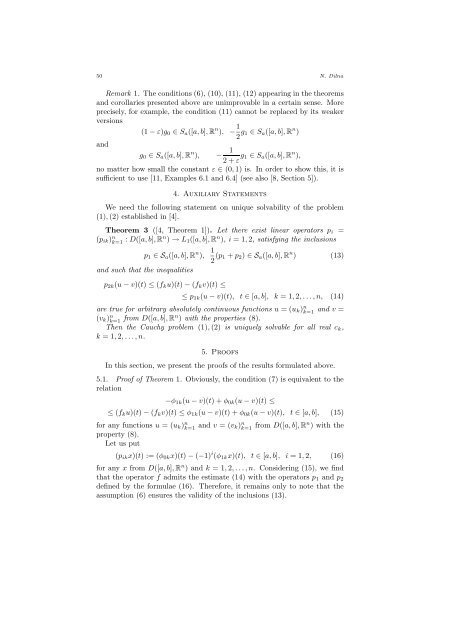ON UNIQUE SOLVABILITY OF THE INITIAL VALUE PROBLEM FOR ...
ON UNIQUE SOLVABILITY OF THE INITIAL VALUE PROBLEM FOR ...
ON UNIQUE SOLVABILITY OF THE INITIAL VALUE PROBLEM FOR ...
You also want an ePaper? Increase the reach of your titles
YUMPU automatically turns print PDFs into web optimized ePapers that Google loves.
50 N. Dilna<br />
Remark 1. The conditions (6), (10), (11), (12) appearing in the theorems<br />
and corollaries presented above are unimprovable in a certain sense. More<br />
precisely, for example, the condition (11) cannot be replaced by its weaker<br />
versions<br />
(1 − ε)g 0 ∈ S a ([a, b], R n ), − 1 2 g 1 ∈ S a ([a, b], R n )<br />
and<br />
g 0 ∈ S a ([a, b], R n ), − 1<br />
2 + ε g 1 ∈ S a ([a, b], R n ),<br />
no matter how small the constant ε ∈ (0, 1) is. In order to show this, it is<br />
sufficient to use [11, Examples 6.1 and 6.4] (see also [8, Section 5]).<br />
4. Auxiliary Statements<br />
We need the following statement on unique solvability of the problem<br />
(1), (2) established in [4].<br />
Theorem 3 ([4, Theorem 1]). Let there exist linear operators p i =<br />
(p ik ) n k=1 : D([a, b], Rn ) → L 1 ([a, b], R n ), i = 1, 2, satisfying the inclusions<br />
p 1 ∈ S a ([a, b], R n ),<br />
and such that the inequalities<br />
p 2k (u − v)(t) ≤ (f k u)(t) − (f k v)(t) ≤<br />
1<br />
2 (p 1 + p 2 ) ∈ S a ([a, b], R n ) (13)<br />
≤ p 1k (u − v)(t), t ∈ [a, b], k = 1, 2, . . . , n, (14)<br />
are true for arbitrary absolutely continuous functions u = (u k ) n k=1 and v =<br />
(v k ) n k=1 from D([a, b], Rn ) with the properties (8).<br />
Then the Cauchy problem (1), (2) is uniquely solvable for all real c k ,<br />
k = 1, 2, . . . , n.<br />
5. Proofs<br />
In this section, we present the proofs of the results formulated above.<br />
5.1. Proof of Theorem 1. Obviously, the condition (7) is equivalent to the<br />
relation<br />
−φ 1k (u − v)(t) + φ 0k (u − v)(t) ≤<br />
≤ (f k u)(t) − (f k v)(t) ≤ φ 1k (u − v)(t) + φ 0k (u − v)(t), t ∈ [a, b], (15)<br />
for any functions u = (u k ) n k=1 and v = (v k) n k=1 from D([a, b], Rn ) with the<br />
property (8).<br />
Let us put<br />
(p ik x)(t) := (φ 0k x)(t) − (−1) i (φ 1k x)(t), t ∈ [a, b], i = 1, 2, (16)<br />
for any x from D([a, b], R n ) and k = 1, 2, . . . , n. Considering (15), we find<br />
that the operator f admits the estimate (14) with the operators p 1 and p 2<br />
defined by the formulae (16). Therefore, it remains only to note that the<br />
assumption (6) ensures the validity of the inclusions (13).

















